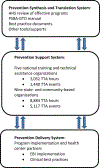Teen Pregnancy Prevention: Implementation of a Multicomponent, Community-Wide Approach
- PMID: 28235440
- PMCID: PMC6521958
- DOI: 10.1016/j.jadohealth.2016.11.002
Teen Pregnancy Prevention: Implementation of a Multicomponent, Community-Wide Approach
Abstract
This article provides an overview and description of implementation activities of the multicomponent, community-wide initiatives of the Teenage Pregnancy Prevention Program initiated in 2010 by the Office of Adolescent Health and the Centers for Disease Control and Prevention. The community-wide initiatives applied the Interactive Systems Framework for dissemination and implementation through training and technical assistance on the key elements of the initiative: implementation of evidence-based teen pregnancy prevention (TPP) interventions; enhancing quality of and access to youth-friendly reproductive health services; educating stakeholders about TPP; working with youth in communities most at risk of teen pregnancy; and mobilizing the community to garner support. Of nearly 12,000 hours of training and technical assistance provided, the majority was for selecting, implementing, and evaluating an evidence-based TPP program. Real-world implementation of a community-wide approach to TPP takes time and effort. This report describes implementation within each of the components and shares lessons learned during planning and implementation phases of the initiative.
Keywords: Adolescent sexual and reproductive health; Community-wide initiatives; Implementation; Interactive systems framework; Technical assistance; Teen pregnancy; Teen pregnancy prevention; Training.
Copyright © 2016 Society for Adolescent Health and Medicine. Published by Elsevier Inc. All rights reserved.
Conflict of interest statement
Figures


Similar articles
-
Implementing Evidence-Based Teen Pregnancy-Prevention Interventions in a Community-Wide Initiative: Building Capacity and Reaching Youth.J Adolesc Health. 2017 Mar;60(3S):S18-S23. doi: 10.1016/j.jadohealth.2016.08.013. J Adolesc Health. 2017. PMID: 28235430 Free PMC article.
-
Efforts to Increase Implementation of Evidence-Based Clinical Practices to Improve Adolescent-Friendly Reproductive Health Services.J Adolesc Health. 2017 Mar;60(3S):S30-S37. doi: 10.1016/j.jadohealth.2016.07.017. J Adolesc Health. 2017. PMID: 28235433 Free PMC article.
-
Implementation of Community-Wide Teen Pregnancy Prevention Initiatives: Focus on Partnerships.J Adolesc Health. 2017 Mar;60(3S):S7-S8. doi: 10.1016/j.jadohealth.2016.12.009. J Adolesc Health. 2017. PMID: 28235439 Free PMC article. Review.
-
Why We Need Evidence-Based, Community-Wide Approaches for Prevention of Teen Pregnancy.J Adolesc Health. 2017 Mar;60(3S):S3-S6. doi: 10.1016/j.jadohealth.2016.12.007. J Adolesc Health. 2017. PMID: 28235432 Free PMC article. Review.
-
Practical Approaches to Evaluating Progress and Outcomes in Community-Wide Teen Pregnancy Prevention Initiatives.J Adolesc Health. 2017 Mar;60(3S):S63-S68. doi: 10.1016/j.jadohealth.2016.09.018. J Adolesc Health. 2017. PMID: 28235438 Review.
Cited by
-
The Teen Access and Quality Initiative: Improving Adolescent Reproductive Health Best Practices in Publicly Funded Health Centers.J Community Health. 2020 Jun;45(3):615-625. doi: 10.1007/s10900-019-00781-z. J Community Health. 2020. PMID: 31820301 Free PMC article.
-
Creating Systems-Level Change to Better Support Expectant and Parenting Young People: A Case Study.Matern Child Health J. 2020 Sep;24(Suppl 2):171-177. doi: 10.1007/s10995-020-02991-7. Matern Child Health J. 2020. PMID: 32889683 Free PMC article.
-
Implementing Evidence-Based Teen Pregnancy-Prevention Interventions in a Community-Wide Initiative: Building Capacity and Reaching Youth.J Adolesc Health. 2017 Mar;60(3S):S18-S23. doi: 10.1016/j.jadohealth.2016.08.013. J Adolesc Health. 2017. PMID: 28235430 Free PMC article.
-
Effects of Community-Wide Teen Pregnancy Prevention Initiatives on Local Teen Birth Rates in the United States: A Synthetic Control Approach.Prev Sci. 2024 Apr;25(3):545-565. doi: 10.1007/s11121-024-01663-0. Epub 2024 Apr 5. Prev Sci. 2024. PMID: 38578374 Free PMC article.
-
Proximate and distal factors associated with the stall in the decline of adolescent pregnancy in Uganda.BMC Public Health. 2021 Oct 18;21(1):1875. doi: 10.1186/s12889-021-11403-6. BMC Public Health. 2021. PMID: 34663262 Free PMC article.
References
-
- Hamilton BE, Ventura SJ, Osterman MJ. Births: Preliminary data for 2015. Natl Vital Stat Rep 2016;65. - PubMed
-
- Romero L, Pazol K, Warner L, et al. Reduced disparities in birth rates among teens aged 15–19 Years - United States, 2006–2007 and 2013–2014. MMWR Morb Mortal Wkly Rep 2016;65:409–14. - PubMed
-
- Ventura SJ, Hamilton BE, Matthews TJ. National and state patterns of teen births in the United States, 1940–2013. Natl Vital Stat Rep 2014;63:1–34. - PubMed
-
- Haskins R, Baron J. Part 6: The Obama Administration’s evidence-based social based policy initiatives: an Overview. In: Evidence for Social Policy and Practice: Perspectives on How Research and Evidence Can Influence Decision Making in Public Services London: NESTA; 2011.
Publication types
MeSH terms
Grants and funding
LinkOut - more resources
Full Text Sources
Other Literature Sources
Medical

